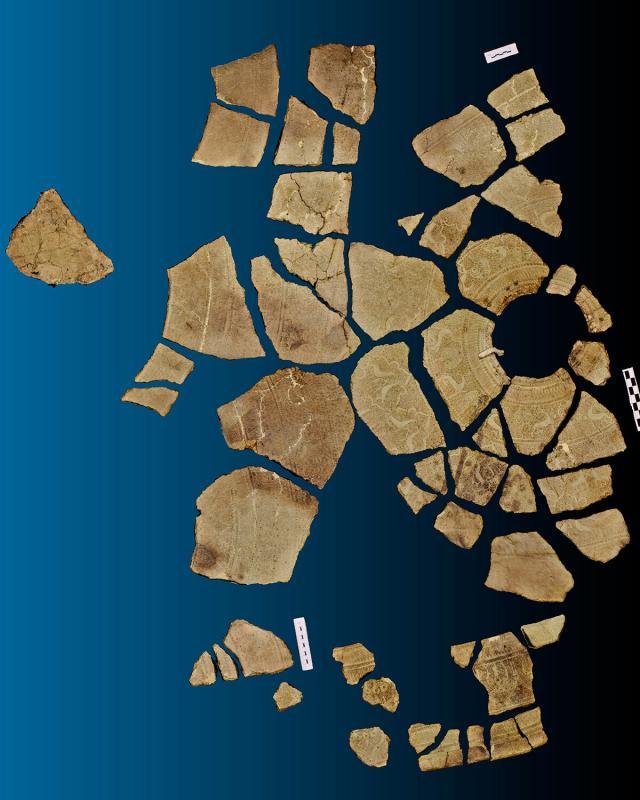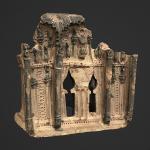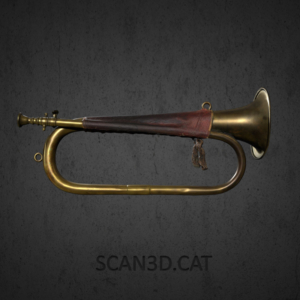Andalusian ceramic jar and its support – 13th century.
In the past year 2020, Scan3D collaborated with the Archaeology Laboratory of the University of Lleida (UdL), through the Paeria de Lleida, in the digitization of an Andalusian ceramic jar and its 13th-century support found in significant archaeological excavations in the La Cuirassa neighborhood of the city of Lleida. These excavations were carried out between 2015 and 2017. We traveled to the University for this project.
The project involved 56 fragments of an Andalusian ceramic jar from the Almohad period, specifically from the 13th century, and the unique supporting structure that held it, of which no other with the same characteristics is known to exist on the Iberian Peninsula.
The digitization project required the use of a 3D scanner (which is why they contacted Scan3D), as it was essential to ensure that the measurements of the jar fragments matched the originals precisely for the purpose of three-dimensional reconstruction. In this case, digital photogrammetry couldn’t be used as the results with this technique were not entirely precise. For this project, we used a high-resolution structured light 3D scanner from Artec.
The process was overseen by the Municipal Archaeologist of the Paeria de Lleida, Xavier Payà, and the archaeologist Joan Eusebi Garcia Biosca. Due to their fragility and significance, the pieces were handled at all times by Carme Prats and Maria Trigo, responsible for the Archaeology Laboratory of the University of Lleida (UdL), who carried out the meticulous and excellent restoration work on the mentioned pieces.”
The urbanization works carried out in the old Seminary district between the spring of 2015 and the summer of 2017, covering an area of over 6000 square meters, allowed for the recovery of significant remains of a prosperous house from the 14th century (named the Pogromo House). This house was set on fire by the Christians living in Lleida at that time with the aim of expelling the Jews who resided in the vicinity of the Jewish La Cuirassa neighborhood of the capital of Segrià (inhabited by the Jewish community of Lleida between the 12th and 15th centuries) on August 13, 1391, and has brought to light several relics. These findings constitute an archaeological site with unique pieces on the Iberian Peninsula.
Among the various pieces that were restored and preserved, the discovery of a jar supported by a base stands out, of which no other as intact is known. Among the objects found so far, there are defensive weapons (a sword, a short hand weapon, and an iron axe), iron oil lamps, fragments of candlesticks, two copper pans, ceramic pieces (some decorated in green and manganese), remnants of textiles, and pieces of wood belonging to the house’s furniture, in addition to a spectacular find, as the archaeologists assert.
The jar (consisting of 56 fragments) is adorned with motifs typical of Muslim iconography (the tree of life, protective gazelles, arches, etc.) and could have been manufactured in the 13th century by master potters from the Almohad kingdom of Murcia and Granada. The state of preservation of the piece made it challenging to restore its volume, according to Carme Prats.

Once the 3D presentation has started,
maximize to full screen to observe the 360º detail.
“The support, the jar, and the washbasin.
Beneath the weapons, almost fully intact, was the support in the form of an architectural model for a jar. On the front, a reproduction of the facade of an Andalusian courtyard with two entrances to the main hall is depicted. It is preceded by a portico with three arches supported by columns, where the central one, of larger dimensions, is latticed, and the lateral ones are lobed.
The facade is adorned with pairs of small applied animals and a lion in the center under which is the drainage hole for the water dripped by the jar that was above the support. To emphasize the decoration, the potter applied dark green glass to all the elements that protrude from the facade (arches, columns, and applied figures), decorating the background with stamped rosettes, holes, and incised lines scattered across the entire surface, also found on the feet, edges, and side walls where the windows are located.
This is a piece with thick walls and less refined clay that supported the weight of a jar filled with water, which could hold between 50 and 70 liters, reinforced with internal ribs that act as buttresses and strengthen the jar’s support base. It is a product of the Almohad period manufactured in workshops located in the city of Murcia (MARTINEZ, PONZE, 1998) during the first half of the 13th century and is currently the first support of this kind with a tripartite facade (NAVARRO, 1987, 24 and 44-45, fig.19, NAVARRO, JIMÉNEZ, 1995, 290) found intact on the Iberian Peninsula.
Next to the support, the jar appeared, in this case, broken into many fragments and flattened by the partition walls of the first floor. The strong impact from the fall scattered the fragments until they reached the south closure wall of the room, which was the facade of the street below and, as it was replaced by another one in modern times, resulted in the loss of 30% of the volume of the jar, the base, part of the body, and half of the neck and rim.
It is a completely decorated piece (rim, neck, and belly) with stamped and incised motifs on a thin layer of refined clay, about 3 or 4 millimeters thick (MARTÍNEZ, MARTÍNEZ, 2009: 62, pl. 5), applied on white and yellowish, porous, undercooked pastes with thick additives. The decoration is divided into six registers separated by lines of stamped rosettes. Inside these bands, there are facing gazelles and profiled birds between lobed arches and columns, trees or palm trees protected by gazelles, geometric motifs in the shape of crosses on a background of spirals, and others filled with drops or tears.
You can also see some small random holes that penetrate the primer layer, as found in other jars discovered in Elda (Alicante) (FRANCO, CONSTÁN, 2016, p. 50, fig. 23) and Jumella (Murcia) (HERNÁNDEZ, SIMÓN, 2016, p.68, fig. 3.3), described as part of the decoration. We believe that the purpose of these holes was to facilitate transpiration by bringing the exterior into contact with the jar’s paste, which was slightly impermeabilized by the engobe that supported the decoration. Due to the contrast between the external and internal temperatures, some of the water contained inside would condense on the walls and drip down to the base of the support (SÁNCHEZ, PÉREZ, 2013, p. 2-3), from where it would exit through that small hole located beneath the lion.
There has been much debate about the iconography represented in the decoration of these jars and their significance, attributing a prophylactic function to them, as in the Andalusian world, it was believed that evil spirits hid inside these containers (SÁNCHEZ, PÉREZ, 2013, p. 8; NAVARRO, JIMÉNEZ, 2002, p. 147). Recently, new interpretations have been put forward, suggesting that it goes beyond protecting water, serving as a true visual metaphor for the Garden of Paradise (AMORES, 2016, p. 74).
The third piece that was part of the triad is the washbasin that collected the water spilled by the support. It is the worst preserved, and at the time of the fire, it was in a storage room. Only a few fragments had been preserved, but we were able to reconstruct the entire profile, confirming that it is a piece manufactured by the artisans and potters who also produced the jar and the support.
The jar, the support, and the washbasin formed a triad with a dual functionality: as decorative prestige elements, located in the corners of courtyards or inside the main rooms of Andalusian houses, and as true coolers, much like water pitchers in the summer, always moist on the outside with cool water inside. It’s worth noting that these were containers used for the water required for ablutions before prayer and for drinking inside the homes.
When this piece was caught in the fire, it was a true antique that was over 150 years old and had been restored with six lead staples that reconnected the neck with the body. In other parts of the house, we recovered several fragments of these productions, which allowed us to account for two more jars and a fragment of vertical walls, possibly the remains of another support or washbasin. Therefore, the household could have been made up of two more such triads.
In the case of the supports, these were custom-made pieces by local potters to decorate the prosperous houses of the Almohad period, as their recovery in archaeological contexts is very limited to Murcia, Écija, and Lorca. Therefore, without excluding the possibility that they were acquired through the trade contacts accessible to the house owner, it doesn’t seem far-fetched to consider the possibility that they were part of the belongings of a Jewish family originally from southern Spain, perhaps from the city of Murcia, who relocated to La Cuirassa in Lleida in the mid-13th century.”
Descriptive text of the most important pieces recovered, prepared by the Municipal Archaeologist of the Paeria de Lleida, Xavier Payà.
Excerpt from the Annual Report of the Activity of the SCT-Archaeology Laboratory of the University of Lleida during the year 2020 – Maria Trigo:
“… As for the large jar and the Andalusian-style architectural model support found within the burnt house in La Cuirassa, we can say that a 3D reproduction of this unique ensemble has been successfully achieved. The architectural model support had already been restored in 2017, and the numerous fragments of the jar were individually cleaned throughout 2018. This digital reproduction has enabled the virtual assembly of the entire jar.
Unfortunately, this is something that cannot be accomplished manually due to the fragility and deformation present in each of the fragments. The results obtained, aside from showcasing the beauty and form of this large vessel, will be of great utility in finding the best way to make the exhibition of this remarkable object possible.
This work was made possible thanks to Lluís Casademunt from the company Scan3D, and the archaeologist Joan Eusebi Garcia Biosca. Lluís was responsible for the scanning of both the support and each individual fragment of the jar, and subsequently, Joan digitally fitted all the jar fragments together to restore the original shape (see figure 4).”














